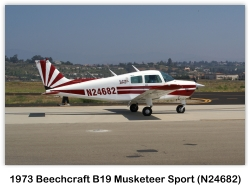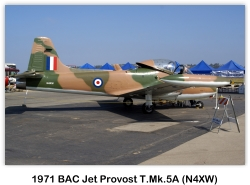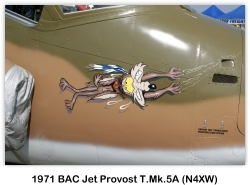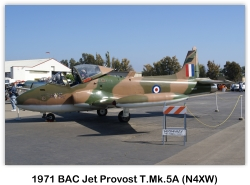

2008 Camarillo Air Show
August 2008 — Camarillo, California
Mally Lewis and Lamb Chop
2008 Camarillo Air Show "Grand Marshals"

Advanced Aviation "Carrera"
N77DK
The Carrera is a two-seat ultralight aircraft marketed for home building. Designed by Advanced Aeromarine, it has also been marketed by Advanced Aviation and Arnet Pereyra Inc. It is a high-wing taildragger aircraft of pusher configuration with side-by-side seating. It is of fabric-covered tubular construction.

1946 Aeronca 7DC "Champ"
N7788C, s/n 7AC-5928
The Aeronca Champion, more commonly known as the Champ, is a single-engine, two-seat, fixed conventional gear airplane. Designed for flight training and personal use, it entered production in the United States in 1945.


Aerospatiale HH-65C "Dolphin"
Model SA366G1, USCG 6590
The HH-65 Dolphin is a twin-engine, single main rotor, MEDEVAC-capable, Search and Rescue (SAR) helicopter operated by the United States Coast Guard (USCG). It is a variant of the French-built Eurocopter Dauphin. The SA366 G1 Dauphin version was selected by the United States Coast Guard in 1979 as its new short range recovery (SRR) air-sea rescue helicopter, replacing the Sikorsky HH-52A Sea Guard. In total 99 helicopters, optimised for the USCG's search and rescue role tasks and given the designation HH-65A Dolphin, were acquired. The HH-65A is not able to perform water landings. The HH-65 normally carries a crew of four: Pilot, Copilot, Flight Mechanic and Rescue Swimmer.


2006 American Champion 7GCBC "Citabria Explorer"
N952B, s/n 1408-2006
The Citabria is a light single-engine, two-seat, fixed conventional gear airplane which entered production in the United States in 1964. Designed for flight training, utility, and personal use, it is capable of sustaining aerobatic stresses (+5/-2g). Its name, "airbatic" spelled Backward, reflects this.

2007 American Champion 8GCBC "Scout"
N292BC
The 8GCBC Scout is a two-seat, high-wing, single-engine fixed conventional gear general aviation airplane which entered production in the United States in 1974. Designed for personal and commercial use, it is commonly found in utility roles such as bush flying—thanks to its short take off and landing (STOL) ability—as well as agriculture, pipeline patrol, and glider and banner towing.


2008 American Champion 8KCAB "Super Decathlon"
N335DS
The 8KCAB Decathlon and Super Decathlon are two-seat fixed conventional gear light airplanes designed for flight training and personal use and capable of sustaining aerobatic stresses (+6/-5g). The Decathlon entered production in the United States in 1970 as a more powerful and stronger complement to the Citabria line of aircraft.

2007 Aviat Pitts S-2C "Special"
N110BK, s/n 6007
The Pitts Special is a light aerobatic biplane designed by Curtis Pitts. It has accumulated many competition wins since its first flight in 1944. The Pitts Special dominated world aerobatic competition in the 1960s and 1970s and, even today, remains a potent competition aircraft in the lower categories.





BAC Jet Provost T.Mk.5A
N4XW, s/n XW435
The BAC Jet Provost (originally built by Hunting Percival) was a British jet-powered trainer aircraft used by the Royal Air Force (RAF) from 1955 to 1993.
1973 Beechcraft Sport B19
N24682, s/n MB-572
The Beechcraft Sport B19 is a two-seat (optional four-seat) cabin sporting and training monoplane that was introduced in December 1971.

1959 Beechcraft B95 Travel Air
N9610R, s/n TD-303
Bearing a name that was carried by all the early aircraft designed by the late Walter H. Beech, the Travel Air is a four-seat executive aircraft, of which the prototype made its first flight on August 6, 1956. lt received its CAA Type Certificate on June 18, 1957.


1979 Beechcraft Bonanza A36
N6039R, s/n E-1489
This version of the Bonanza, introduced in mid-1968, is a full six-seat utility aircraft developed from the Bonanza Model V35B. It is generally similar to the V35B, but has a conventional tail unit with sweptBack vertical surfaces, similar to that of the F33 series of Bonanzas. In addition, the A36 has large double doors on the starboard side of the fuselage aft of the wing root, to facilitate loading and unloading of bulky cargo when used in a utility role.


1965 Beechcraft Bonanza S35
N789R, s/n D-7777
The prototype Bonanza flew for the first time on December 22, 1945, and the type went into production in 1947. A total of 7,787 had been built by March 1965. Optional extras available on the Bonanza included the Beech-designed "Magic Hand" introduced in May 1965. Designed to eliminate the possibility of wheels-up landing or inadvertent retraction of the landing gear on the ground, it lowers the gear automatically on approach when the engine manifold pressure falls below approximately 20 in (50 cm) and airspeed has been reduced to 120 mph (193 kmh). On take-off, it keeps the gear down until the aircraft is airborne and has accelerated to 90 mph (145 kmh) IAS. The pilot at will can switch off the system.

Beechcraft T-34B Mentor
N341MR, BuNo 140731
The Beechcraft T-34B Mentor is a propeller-driven, single-engine, United States Navy military trainer aircraft derived from the Beechcraft Model 35 Bonanza. The earlier versions of the T-34, dating from around the late 1940s to the 1950s, were piston-engine. These were eventually succeeded by the upgraded T-34C Turbo-Mentor, powered by a turboprop engine. The T-34 remains in service almost six decades after it was first designed.



1969 Bell Model 205A-1 "Huey"
N205VC, s/n 30066
The Bell 204 and 205 are the civil versions of the ubiquitous UH-1 Iroquois single-engine military helicopters. They are type-certificated in the transport category and are used in a wide variety of applications, including crop dusting, cargo lifting, and one of its most common uses, aerial firefighting.

Bell Textron Model 206L-1
N316SP
The 206L LongRanger is a stretched variant with seating for seven (the LongRanger, stretched a total of 30 inches (760 mm), adds two rear-facing seats in between the front and rear seats). Since their first delivery in 1975, Bell has produced more than 1,700 Ls across all variant types. In 1981 a military version was released, the 206L "TexasRanger". The original 206L utilized a Allison 250-C20B engine, and a series of model upgrades replaced this engine with more powerful versions; the 206L-1 used a 250-C28 and the 206L-3 and 206L-4 used the 250-C30P with 490 shaft horsepower. In 2007, Bell announced an upgrade program for the 206L-1 and 206L-3 which is designed to modify the aircraft to the 206L-4 configuration; modified aircraft are designated 206L-1+ and 206L-3+. Modifications include strengthened airframe structural components (including a new tailboom), improved transmission, upgraded engine for the L-1, all of which result in a max gross weight increase of 300 pounds and increased performance.



Bell UH-1H-BH "Iroquois"
US Army 73-21858
The UH-1 Iroquois is a multipurpose military helicopter, famous for its use in the Vietnam War. It is commonly known as (or officially in the U.S. Marine Corps) the "Huey." The UH-1 was developed by Bell Helicopter from 1955 US Army trials with the Bell Model 204. The initial designation of HU-1 (helicopter utility) led to its nickname, Huey. The aircraft was first used by the military in 1959 and went into tri-service production in 1962 as the UH-1. The last were produced in 1976 with more than 16,000 made in total, of which about 7,000 saw use during the Vietnam War.

1942 Boeing-Stearman A75N1
N56245, s/n 75-4284
The Stearman (Boeing) Model 75 is a biplane, of which at least 9,783 were built in the United States during the 1930s and 1940s as a military trainer aircraft. Stearman became a subsidiary of Boeing in 1934. Widely known as the Stearman, Boeing Stearman or Kaydet, it served as a Primary trainer for the USAAF, as a basic trainer for the USN (as the NS & N2S), and with the RCAF as the Kaydet throughout World War II. After the conflict was over, thousands of surplus aircraft were sold on the civil market. In the immediate post-war years they became popular as crop dusters and as sports planes.



1999 Bombardier BD-700-1A10
N421SZ, s/n 9056
The Bombardier Global Express is an ultra long range corporate and VIP high speed jet aircraft produced by Bombardier Aerospace. The Bombardier Global 5000 is a slightly shorter version. The Global Express has also been modified for military missions, such as the Raytheon Sentinel R1.

1971 Britten-Norman BN-2 "Islander"
N55JA, s/n 295
The Britten-Norman BN-2 Islander is a 1960s British light utility aircraft, mainline airliner and cargo aircraft designed and originally manufactured by Britten-Norman of the United Kingdom. The Islander is one of the best-selling commercial aircraft types produced in Europe. Although designed in the 1960s, over 750 are still in service with commercial operators around the world. The aircraft is also used by the Army and Police forces in the United Kingdom and is a light transport with over 30 military aviation operators around the world.

1946 Cessna 140
NC77275, s/n 11488
The Cessna 120 and the Cessna 140 are single engine, two-seat, light general aviation aircraft that were first produced in 1946, immediately following the end of World War II. Production ended in 1950, and was succeeded by the Cessna 150, a similar two-seat trainer which introduced a tricycle gear. The 120 and the 140, together, sold 7,664 copies in the five years that the aircraft were produced.


1952 Cessna 170B
N170BG, s/n 25392
The Cessna 170 is a light, single-engine, general aviation aircraft produced by the Cessna Aircraft Company between 1948 and 1956. In 1952, the Cessna 170B was introduced featuring a new wing incorporating dihedral similar to the military version. The B model was equipped with very effective modified-Fowler (slotted, rearward-traveling) wing flaps which deflect up to 40° and a wing design that lives on in the Cessna light singles of today (constant NACA 2412 section with a chord of 64 inches (1,600 mm) from centerline to 100 inches (2,500 mm) out, then tapering to 44-inch (1,100 mm) NACA 2412 section chord at 208 inches from centerline, with three-degree washout across the tapered section). The 170B model also included a new tailplane, a revised tailwheel, larger rear windows and other refinements over the 170 and 170A. In 1955, the previously elliptical rear side windows were changed to a more square design.

1953 Cessna 170B
N4695C, s/n 25639
The Cessna 170 is a light, single-engine, general aviation aircraft produced by the Cessna Aircraft Company between 1948 and 1956. In 1952, the Cessna 170B was introduced featuring a new wing incorporating dihedral similar to the military version. The B model was equipped with very effective modified-Fowler (slotted, rearward-traveling) wing flaps which deflect up to 40° and a wing design that lives on in the Cessna light singles of today (constant NACA 2412 section with a chord of 64 inches (1,600 mm) from centerline to 100 inches (2,500 mm) out, then tapering to 44-inch (1,100 mm) NACA 2412 section chord at 208 inches from centerline, with three-degree washout across the tapered section). The 170B model also included a new tailplane, a revised tailwheel, larger rear windows and other refinements over the 170 and 170A. In 1955, the previously elliptical rear side windows were changed to a more square design.

1978 Cessna A185F "Skywagon II"
N197RD, s/n 18503681
The Cessna 185, also known as the Skywagon, is a six-seat, single engine, general aviation light aircraft manufactured by Cessna. It first flew as a prototype in July 1960, with the first production model being completed in March 1961. The Cessna 185 is a high-winged aircraft with non-retractable conventional landing gear and a tailwheel. Over 4,400 were built with production ceasing in 1985. Production ceased in large part in 1985 due to two factors: the demise of the general aviation boom that characterized the post World War II years in the United States, and the growing awareness by insurance companies that tail wheel aircraft were harder to insure due to their handling characteristics during takeoff and landing. When Cessna re-introduced some of its most popular models in the 1990s, the tailwheel equipped Cessna 180 and 185 were left to the history books and not resurrected.

1999 Cirrus VK-30
N52TH, s/n 143
The Cirrus VK-30 is a single-engine pusher propeller homebuilt aircraft originally sold as a kit by Cirrus Design.




Condor Squadron
North American SNJ/AT-6 Flight Team
Based in Van Nuys, CA, the Condor Squadron is known to aviation fans around the world for our dramatic flights in restored North American AT-6/SNJ World War II vintage aircraft. A frequent sight over parades and other events throughout Southern California, the Condor Squadron salutes the men and women of our armed forces, and honors the sacrifices they have made.




Curtiss P-40N "Warhawk"
NL85104
The Curtiss P-40 was an American single-engine, single-seat, all-metal fighter and ground attack aircraft that first flew in 1938. It was used by the air forces of 28 nations, including those of most Allied powers during World War II, and remained in front line service until the end of the war. By November 1944, when production of the P-40 ceased, 13,738 had been built, all at Curtiss-Wright Corporation's main production facility at Buffalo, New York.








2004 Diamond Aircraft DA40 "Star"
N183DF, s/n 40.385
The Diamond DA40 Diamond Star is an Austrian four-seat, single engine, light aircraft constructed from composite materials. Built in both Austria and Canada it was developed as a four-seat version of the earlier DA20 by Diamond Aircraft Industries.

2007 Diamond Aircraft DA40 "Star"
N695DS, s/n 40.865
The Diamond DA40 Diamond Star is an Austrian four-seat, single engine, light aircraft constructed from composite materials. Built in both Austria and Canada it was developed as a four-seat version of the earlier DA20 by Diamond Aircraft Industries.

1943 Douglas C-53D "Skytrooper" (D-Day Doll)
N45366, AF 42-68830, s/n 11757
The Douglas C-47 Skytrain or Dakota is a military transport aircraft that was developed from the Douglas DC-3 airliner. It was used extensively by the Allies during World War II and remained in front line operations through the 1950s with a few remaining in operation to this day. During World War II, the armed forces of many countries used the C-47 and modified DC-3s for the transport of troops, cargo and wounded. In Europe, the C-47 and a specialized paratroop variant, the C-53 Skytrooper, were used in vast numbers in the later stages of the war, particularly to tow gliders and drop paratroops. In the Pacific, with careful use of the island landing strips of the Pacific Ocean, C-47s were even used for ferrying soldiers serving in the Pacific theater Back to the United States.





1945 Douglas DC-3C "Mainliner"
N814CL, s/n 34370
The Douglas DC-3 is an American fixed-wing, propeller-driven aircraft whose speed and range revolutionized air transport in the 1930s and 1940s. Because of its lasting impact on the airline industry and World War II it is generally regarded as one of the most significant transport aircraft ever made. Many DC-3s are still used to this day in all parts of the world.

Douglas SBD-5 "Dauntless"'
NX670AM, BuNo 28536
The Douglas SBD Dauntless was a naval dive bomber made by Douglas during World War II. The SBD was the United States Navy's main dive bomber from mid-1940 until late 1943, when it was supplanted, although not entirely replaced, by the SB2C Helldiver.













2008 Eclipse Aviation EA500LX
N500FB, s/n 000185
The Eclipse Aviation 500 is a small six-seat business jet aircraft that was manufactured by Eclipse Aviation. The Eclipse 500 became the first of a new class of Very Light Jets (VLJ) when the first jet was delivered in late 2006. The aircraft is powered by two lightweight Pratt & Whitney Canada PW610F turbofan engines in aft fuselage-mounted nacelles.

1946 Ercoupe 415-C
N799TX, s/n 670
The ERCO Ercoupe is a low wing monoplane first manufactured by the Engineering and Research Corporation (ERCO) shortly before World War II, production continued after WWII by several other manufacturers until 1967. It was designed to be the safest fixed-wing aircraft that aerospace engineering could provide at the time, and the type still enjoys a very faithful following today.

Fairchild 24
EAA Restoration Project
The Fairchild Model 24, a four-seat, single-engine monoplane light transport aircraft that was used by the US Army Air Corps as the UC-61. The Model 24 was itself a development of previous Fairchild models and became a successful civil and military utility aircraft.





Fairchild M62A (PT-19)
N641BP
The Fairchild PT-19 (M62A) was a USA Fairchild Aircraft monoplane primary trainer aircraft that served with the United States Army Air Forces, RAF and RCAF during World War II. It was a contemporary of the Kaydet biplane trainer and was used by the USAAF during Primary Flying Training as the introductory pre-solo phase trainer for introducing new pilots to flying before passing them on to the more agile Kaydet. As with other USAAF trainers of the period, the PT-19 had multiple designations based on the power plant installed.

















































































































































































































































































































































































































Copyright © 1998-2018 (Our 20th Year) Skytamer Images, Whittier, California
ALL RIGHTS RESERVED































